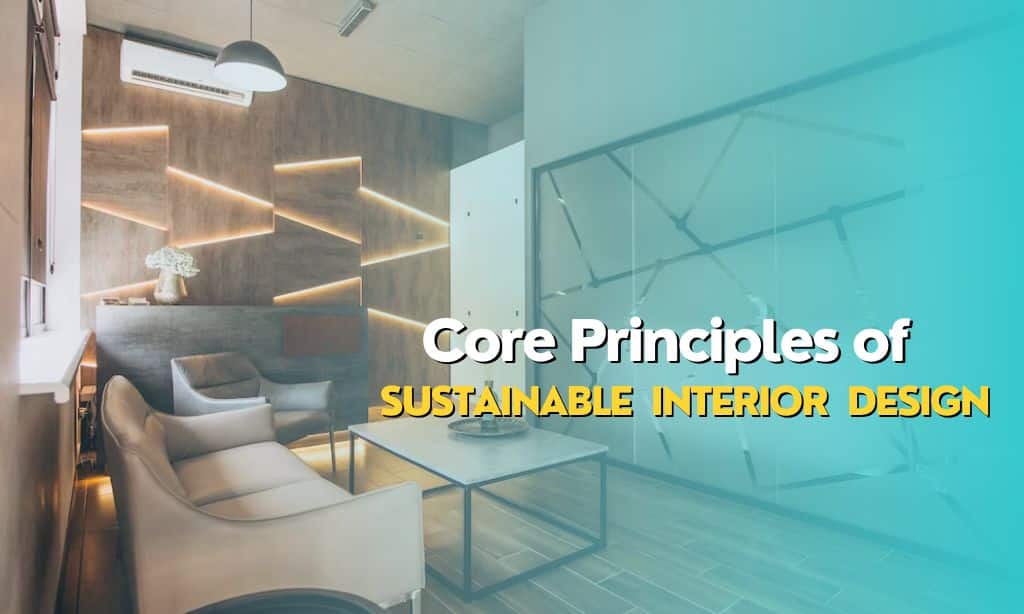Creating an environmentally responsible, healthy home seems increasingly vital as climate change concerns mount. Sustainable interior design offers solutions, guiding construction and decoration while upholding ecological principles. But what defines “green” decor, and how can everyday homeowners put such imprecise concepts into tangible action? Let’s explore everything in this in-depth article.
Content Highlights
- Sustainable interior design conscientiously constructs dwellings upholding environmental ethics using ethically sourced materials for only necessary items demanding limited energy, water, and waste.
- Green home features improve efficiency and wellness through lighting upgrades, insulation boosts, non-toxic furnishings, multifunctional furniture, and recycled material usage.
- Budgets, knowledge gaps, and scheduling delays challenge even modest sustainable interior design projects. Collaborating with specialized contractors simplifies the process.
- Gradually improving existing homes with DIY adjustments or long-range renovation roadmaps allows flexibly crafting perfectly personalized sustainable dwellings matching needs and abilities.
What is sustainable interior design?
In 1987, the Brundtland Commission first coined the oft-quoted concept definition of sustainability, meaning “meeting present needs without compromising future generations’ abilities to meet their own needs.” Respecting ecological limits in all human activities means securing resources long-term through conscientious conservation today.
Within design realms, sustainability promotes sensitivity, minimizing environmental harm associated with structural constructs and material goods we interact with constantly within built spaces. It advocates holistic safeguarding of our limited shared natural world.
For interior decorators, architects, and homeowners, sustainable principles manifest through informed product selection, efficiency-focused features, health-centered choices, responsible sourcing policies, waste reduction tactics, and context-specific enhancements that collectively shrink the eco-footprint of dwellings people occupy daily. This guide will unpack exactly what environmentally conscious interior design entails, along with furnishing actionable tips easily applicable to any home decor context.
Core Principles of Sustainable Interior Design
Several key pillars define sustainable construction and decoration guidelines:
1. Material Optimization
Foremost, green interior design emphasizes judiciously using only the necessary quantities of fundamentally safe and ecologically harmless materials for constructing and outfitting home spaces. It stresses slimming overconsumption burdens through smart design catering to genuine needs rather than extravagant excess. Item durability and an ability to repurpose furnishings later also factor prominently.
2. Energy Efficiency
Environmentally responsible dwellings incorporate features intentionally limiting non-renewable energy dependencies. This equates to installing high-performance insulation, weatherproofing, heating and cooling systems, and appliances that exceed minimum efficiencies while maximizing natural light, ventilation, and passive solar warmth influences. Conservation through renewables like solar further ameliorates grid reliance.
3. Water Conservancy
Water cropping and purification demands also burden environmental reserves, making sustainable construction attentive to bath, kitchen, and outdoor landscaping efficiencies. Low-flow plumbing fixtures, drought-tolerant or native plantings, and conservation irrigation measures greatly reduce liquid footprints. Rain capture further offsets municipal water utilization.
4. Health and Wellness
Green design selects materials that avoid toxic offgassing or give occupants high exposure to harmful finishers through intentional product specifications, benefiting indoor air quality and wellness. Circadian rhythm-aligned lighting schemas further nurture holistic inhabitant health.
5. Responsible Sourcing
Environmental diligence tracks sourcing and production methods associated with finishing products like wood, textiles, paints, and flooring to ensure sustainability-aligned processes that minimize ecological damages. Chain of custody documentation demonstrates accountability. Reclaimed, recycled, or sustainably harvested materials provide preferred options.
6. Waste reduction
The most sustainable design approach equates creating less waste initially with addressing leftovers post-production. Tactics like designing timeless modular pieces readily adapted to new uses, limiting material cut-offs through strategic layouts, and seeking reusable, recyclable, or compostable furnishing and decor items shape waste-conscious interiors.Additionally, you can also read about- Reducing Your Energy Bills Through Smart Interior Design
36 Tips to Incorporate Sustainability into Your Home’s Interior Design
Transforming interiors by embracing greening concepts seems vaguely overwhelming. Where should everyday homeowners focus first? Consider these 36 tips to make sustainability conveniently attainable in 2024:
1. Upgrade lighting
Swap outdated lighting systems with long-lasting, highly efficient LED bulb installations. Smart sensor switches and natural light maximizations like skylights or reflective tubing lessen unnecessary usage. Programmable and dimer-capable fixtures enable custom-tailored, needs-based illumination.
2. Improve thermal envelopes
Sealing any leaks around doors and windows while enhancing insulation, weather stripping, and caulking retains interior temperature regulation, minimizing heating and cooling ramping to compensate for losses. Annual audits ensure continual optimization. High-efficiency HVAC systems further minimize energy waste.
3. Install eco-friendly flooring
Natural fiber carpeting, recycled content tiles, sustainably sourced bamboo, or reclaimed wood floors offer renewable, non-toxic alternatives to wall-to-wall synthetic materials. Look for tamper-evident chain of custody assurances. Proper installation also prevents offgassing and optimizes durability.
4. Use low- or zero-VOC paints and finishes
Volatile organic compounds (VOCs) offgas toxic fumes, damaging air quality and health. Low-VOC and botanically derived options avoid harsh lingering smells and chemicals. Milk or clay-based applications add zero-emission, renewable plant-sourced finishes safely.
5. Seek greener textiles
Organic cotton, bamboo, hemp, recycled polyester/nylon, wool, and other fabrics dyed or treated using non-toxic processes align with sustainability. Fair-wage artisans producing handcrafted goods ethically also make conscientious sourcing amenable to custom draperies, bedding, and décor items.
6. Upcycle, Repurpose and Reuse
Give existing furnishings and architectural elements inventive second lives instead of landfilling recoverable materials. Creative upcycling, remodeling, or repairing reimagines possibilities while embedding things with renewed sentimental enrichment. Customized DIY solutions showcased on design media illustrate attainable techniques adaptable to personal contexts and skill comfort levels.
7. Design multifunctional modules
Choosing furniture, storage, and organizational systems that do double or triple duty maximizes usable square footage ratios in sometimes confined residential spaces. For example, convertible coffee tables with lift tops for dining or hidden storage furniture facilitate room fluidity and clutter containment while demanding fewer raw materials to serve needs.
8. Incorporate sustainable outdoor living areas
Eco-conscious patios, gardens, and living spaces better integrate homes within surrounding native environments through plantings that benefit wildlife. They allow occupants immersive nature connections. Renewable and recycled decking materials, energy-efficient outdoor lighting and heating, compost piles, and rain barrel irrigation systems further align spaces with greening goals.
9. Choose lighter colors
Opt for light-colored paints and furnishings to reflect more natural light, reducing the need for artificial lighting and saving energy costs. Seek out eco-friendly, low-VOC paint options that are less harsh on the environment and indoor air quality, as mentioned above. Strategically incorporate reflective surfaces to maximize light diffusion between rooms. This natural, passive lighting cuts lighting and electricity usage. Discuss these sustainable interior design approaches with contractors to green your home in a budget-friendly way.
10. Include green furniture
Eco-friendly furniture options are now widely available at reasonable prices. Opt for couches and other items constructed from durable, ethically sourced materials like high-quality leather and organic cotton. Prioritize longevity and low maintenance when furnishing sustainably. Seek out pieces that are stain-resistant and cleanable with non-toxic products. Doing a bit of research to find durable, environmentally-conscious furniture that fits your budget and lifestyle is easier these days. Investing in quality, sustainable furnishings often saves money and hassle over time.
11. Utilize renewable sources of energy
Transitioning to renewable energy helps build a sustainable home. Install solar panels if you plan to occupy your residence long-term. Despite substantial upfront costs, solar energy pays dividends through radically reduced electric bills and a minimized carbon footprint over time. Solar panel installation makes environmental and financial sense for committed homeowners seeking energy independence and contributing to a green future. Discuss solar and renewable energy options with contractors to leverage solar and wind power instead of fossil fuels. An eco-friendly, energy-efficient home aligns environmental impact with household economics. If you want you can also read- Reasons Why Interior Designers are a Must
12. Use energy-saving gadgets
Installing energy-efficient equipment can make homes more eco-friendly. Opt for energy-saving lightbulbs, boosters, and smart devices that use less electricity. For example, buy a microwave with the Energy Star label and low wattage. This type of appliance reduces power bills and carbon footprints thanks to lower energy consumption and emissions.
13. Try placing rugs
Rugs serve decorative and functional purposes. They insulate rooms by retaining heat and absorbing sound. Rugs can also improve air quality by trapping dust until vacuumed. For sustainable interior design, choose organic, easily cleanable rugs over options requiring environmentally harmful dry cleaning or chemicals.
14. Have reliable windows
Windows play a key role in sustainable interior design and home energy efficiency. Proper insulation blocks heat transfer and drafts. If you are unable to replace windows, window coverings provide an affordable solution for regulating sunlight and temperature. Open and close coverings as needed to control cold and heat flow. Overall, strategic window treatment reduces energy waste, helping create an eco-friendly home.
15. Install effective faucets and showerheads
Installing water-efficient faucets and showerheads saves both water and electricity. Many new models cut water use by up to 70%. Eco-friendly interior design often requires a thoughtful, research-based approach rather than endless resources. Simple upgrades like energy and water-saving fixtures make homes greener.
16. Prioritize durability
Prioritizing durable building materials and appliances increases a home’s sustainability. Investing in long-lasting solutions saves money and protects the environment, compared to disposable items that often end up in landfills. When selecting sustainable interior finishes and furnishings—whether flooring, lighting, or textiles—choose quality craftsmanship built to last over trendy fast fashion. Extending useful lifespans allows homeowners to get the most out of purchases while reducing waste.
17. Include plants in your design
Indoor plants enhance sustainability and wellness. As natural air purifiers, plants absorb carbon dioxide and emit oxygen. Their presence also diminishes stress. For easy care, choose plants like spider plants, snake plants, or peace lilies. Incorporating greenery into interior spaces improves air quality and refreshes the spirit.
18. Utilize your space in the most effective way
Strategic use of interior space minimizes environmental impact. Microhousing models this well. Usually 300 square feet or less, these convenient apartments cater to urban areas with surging populations. Built-in appliances save room, as do other space-saving furnishings. Smart construction reduces the materials and resources needed. Some micro-housing even meets LEED green building standards. Their efficient design provides sustainable housing.
19. Select local if possible
Choose sustainably and locally produced furnishings and fair trade decor. When possible, shop local. Supporting ethical brands that closely monitor their supply chains supports good labor practices and responsible manufacturing. It also reduces transport emissions by sourcing locally. Eco-friendly interiors value artisan craftsmanship and social justice.
20. Use biophilic design
Biophilic design integrates nature into built environments. Living walls, rooftop gardens, and atriums connect people to the outdoors. Guiding principles include using natural elements, organic forms, dynamic processes that mimic nature, sunlight, local materials, and ancestral ties to the land. This approach taps into our innate affinity for the natural world while conserving resources. A space flowing with botanicals, dappled light, and views nourishes the soul. Biophilic architecture beautifully aligns human and ecological habitats.
21. Consider LCA, or life cycle assessment
Conduct a life-cycle assessment when selecting design materials. Examine each product’s full environmental impact, from raw material extraction through manufacturing, transportation, usage, and disposal. Understanding this cradle-to-grave analysis highlights more and less sustainable options. For instance, versatile bamboo rates well. As a rapidly renewable plant-based material, bamboo construction products and furnishings help reduce carbon footprints. Overall, evaluating material and production impacts allows designers to prototype greener projects.
22. Don’t forget your kitchen
Outfit kitchens with energy-efficient appliances boasting Energy Star ratings. Eco-conscious countertop and cabinet materials include bamboo and recycled glass. Small upgrades add up, creating more sustainable spaces. Prioritizing green kitchen features conserves electricity and natural resources while decreasing environmental footprints.
23. Use cork wallpaper
For sustainable, textured walls, choose natural cork wallpaper. Derived from renewable cork oak bark, this versatile material brings warmth and nature indoors. Cork resists mold and bacteria too. Pair with jute rugs, poufs, and rope lights for an earthy aesthetic. Durable and easy to maintain, cork stands up to moisture and cleaners. An eco-friendly alternative is perfect for any season.
24. Try terracotta flooring
Crafted from clay, sustainable terracotta floor tiles add warmth. Their inviting earth-toned hues connect to cultural heritage. More porous than stone, terracotta withstands heavy use in living rooms, kitchens, and bedrooms. The natural material feels pleasingly cool and textured underfoot. Though too permeable for damp areas, these durable yet soft tiles bring ecological benefits indoors. Terracotta reflects an eco-friendly aesthetic.
25. You can also consider concrete flooring
Concrete flooring builds sustainability. Primarily made of cement and water, this adaptable material keeps interiors naturally cool to reduce energy usage. Durable, long-lasting concrete also recycles well, avoiding landfill waste. Easy maintenance and an affordable cost make it attractive green flooring. With eco-conscious design thriving, concrete’s hardwearing minimalism and comforting aesthetic offer an earth-friendly interior solution.
26. Try a false ceiling of wood
Wooden false ceilings sustainably infuse warmth. The renewable material insulates, reducing air conditioning needs. Hardwoods from endangered forests should be avoided; sustainable softwoods offer an eco-friendly alternative. Durable wood lattices pair rustic textures with modern spaces while increasing perceived height. Strategic lighting highlights natural beauty. An earth-toned ceiling links indoors and out, drawing the natural world into urban settings. The resulting biophilia connects us to nature—a balancing act for overall wellness.
27. Include some bamboos
Bamboo room dividers sustainably add privacy. Floor-to-ceiling woven poles partition space naturally with simple elegance. Bamboo’s versatility, strength and fast growth establish its eco-friendly credentials. Strategic accent lighting casts a warm glow on the linear textures, creating an inviting backdrop for minimalist furnishings. Easy care and neutral hues allow this exotic yet calming touch to integrate seamlessly, brightening urban interiors through biophilic design.
28. Design your bedroom with an industrial distressed finish
Industrial style sustainably bridges modern and vintage. Distressed brick walls and reclaimed wood floors form the minimalist backdrop for sleek furnishings. The extensive use of recycled building materials makes this on-trend aesthetic eco-friendly. Despite its sparseness, the creative blending of natural and manufactured elements makes a bold statement. The layering of plants and tactical greenery could further enhance biophilia, connecting occupants to the inherent comfort of nature. Ultimately, industrial interiors reduce waste through inventive repurposing.
29. Use bioglass
Repurposed glass offers a sustainable design material. Recycled bottles and windows get crushed, melted, and compressed into solid slabs. This biodegradable surface then reshapes into décor items, sinks, counters, and floors—limited only by creativity. Upcycled glass endlessly reinvents waste into stylish, eco-friendly interiors.
30. Use biofuel
Fireplaces warm dwellings, but poorly sealed flues waste energy. Transitioning to sustainable biofuels boosts efficiency. Renewable wood pellet inserts or gas models prevent heat loss far better. Programmable thermostats modulate based on usage and need. Smart technology coupled with mindful fuel and maintenance choices allows fireplaces to heat homes economically all season, not just benefiting families but also the planet.
31. Use jute fiber
Fast-growing jute plants yield sustainable fiber for rugs and textiles. The rapid renewal makes their earthy, coarse texture an affordable, eco-friendly design choice. Naturally insulating woven jute rugs introduce warming textures and tones. Their durability and artisanal appeal fashionably keep interiors green.
32. Consider the carbon emission facts carefully
Select low-carbon materials. Seek out carbon-neutral timber, aluminum, and steel. Even better, choose carbon-negative bricks, concrete, or bioplastics sourced from captured pollution. Prioritizing the product’s carbon footprint minimizes its environmental impact. Whether building or furnishing sustainably, using climate-friendly materials is key.
33. Verify your materials
Vet materials for authentic sustainability. Ensure recyclability and responsible sourcing. Dig into vendors’ environmental commitments. The most credible eco-conscious interiors utilize third-party-verified green supply chains, from extraction to manufacture to transportation. Don’t just trust label claims; validating a product’s start-to-finish stewardship safeguards truly green design.
34. Use minimal interiors
“Less is more” rings true for sustainable spaces. Minimalism and mindful essentialism reduce manufacturing and waste. Scandinavian and other stripped-down styles exemplify this eco-ethic through raw, earthy palettes and organic fabrics like linen, cotton, and hemp. Jute rugs and biofueled fireplaces conserve resources for heating. Prioritizing multifunctional, non-toxic furniture made from renewable materials creates unfussy, decluttered interiors that are better for both inhabitants and the planet. Simply designed, nature-inspired homes have an enduring appeal.
35. Use ethical and sustainable candles.
Eco-conscious candles sustainably set the mood. Nontoxic, soy-based waxes emit less smoke and purify indoor air. Their subtle glow warms rooms without tarnishing the walls. Supporting green manufacturers upholds ethical labor standards as well. Conscientious interior lighting kindles cozy spaces while sparking positive social and environmental change.
36. Use your creativity to create your decor.
Crafting your own sustainable decor allows creativity and customization. DIY holiday adornments from nature make eco-friendly statement pieces. Curate photography or artwork into a signature wall collage. Handpicked elements infuse personal history and meaning. Salvaging materials like vintage paperwork for decoupage repurposes waste. Best of all, making your own decor saves money while aligning designs with values. The imperfections connect us to the wabi-sabi beauty of nature’s cycles. One-of-a-kind touches sustain the spirit.
20 Key Benefits of Sustainable Interior Design
Still doubting whether sustainable interior design principles deliver meaningful value beyond quelling abstract ecological anxieties? Holistic advantages benefit home inhabitants too.
1. Healthier indoor living spaces
Avoiding VOC paints and finishes, installing non-toxic fabrics and materials, and efficiently ventilating and dehumidifying the air improve indoor air quality, protecting lungs and overall wellbeing. Allergy sufferers especially notice reduced reactions in green buildings.
2. Greater affordability and increased home valuation
Energy- and water-efficient fixtures, coupled with conscientious upgrades, ultimately lower monthly housing bills. Appraisals also recognize sought-after green remodels. Building certifiable sustainable dwellings facilitates banking, insurance, grants, and real estate incentives, as well as making ownership cheaper.
3. Enhanced Quality of Life
This makes occupants “feel good” immeasurably. Responsible sourcing and upcycling foster global connections and honor environmental ethics, while craft-focused, handmade touches enliven personality. Nature-integrated spaces relieve stress through biophilic joy and tranquility.
4. Good for the planet and people
Mass production damages natural systems, while ethical sourcing protects them. Choosing sustainably made furnishings and finishes cuts manufacturing impacts and transport pollution. It also promotes safe, fair labor conditions. Whether building, renovating, or decorating, green materials and methods preserve ecosystems, uplift communities, and secure the wellbeing of both people and the planet for generations to come. The cumulative impact of conscious interior design choices cannot be overstated.
5. Cleaner air
Eco-friendly soy candles brighten sustainably. Their nontoxic wax and subtle glow warm rooms without smoke buildup. Choosing ethical brands also supports fair labor and purer air. Conscious lighting enhances ambiance and drives wider social and environmental gains.
6. Consistent temperature
Strategic window placement and coverings naturally regulate light and temperature. Analyze sun patterns when sitting in glass openings. Maximize passive solar gain in cooler months; allow ample breeze and shading during warmer seasons. Properly insulating glass and adding operable light-filtering window treatments further prevent heat loss while decreasing the electricity needed for artificial lighting and HVAC systems.
7. Natural lighting
An eco-conscious color palette brightens rooms naturally. Light-reflecting, neutral backdrops like soft whites and airy neutrals maximize daylighting while minimizing the need for artificial lighting. Color also impacts the perceived temperature of a space. Cool hues are calm; warm tones energize and provide the illusion of sunlight on a cloudy day. Strategic finishes and furnishings sustain interiors environmentally as well as aesthetically.
8. Ensures durability
Artisanal goods crafted sustainably from quality components make durable, enduring choices. Their exceptional longevity saves money and averts waste. Ethical, hands-on production protects people and the planet at every link along the supply chain. Far better investments than shoddily made fast furniture destined for landfills after brief use. When we value artistry, materials, and workmanship, cherished possessions last generations.
9. Safe and healthy materials
Sustainable furnishings prioritize nontoxic materials for healthy interiors. Ethically sourced natural components avoid hazardous solvents and off-gassing. While mass production often relies on toxic chemicals, artisanal makers focus on craftsmanship and purity. Their mindful methods boost durability and wellness. Choosing such conscientious, quality construction protects both people and the planet, as mentioned before.
10. Saves the environment
Sustainable design preserves the planet for posterity. Rapidly renewable and responsibly harvested materials like bamboo make durable furnishings without depleting forests. On the other hand, steel production scars the earth and alters soil composition for centuries. The air and water all species rely on suffer too. But mindful sourcing and ethical manufacturing protect the intricate web of life we each depend on. Our everyday choices determine whether ecosystems flourish or falter. For the sake of both current and future generations, let us uplift ecologies and communities through our conscious interior selections.
11. Beautifies the environment
Beautiful, life-sustaining gardens inspire ecological action. Lush green spaces clean air while lifting spirits. Well-tended surroundings motivate neighbors to follow suit, growing community pride. We each have the power to keep public areas pristine when walking dogs or commuting. Though caring for one’s immediate ecosystem is important, we model stewardship as rippling out. Enrolling in courses on sustainable techniques equips us to spread this vital knowledge. Shared wisdom uplifts individual homes and the collective landscape. Come learn practical ways to benefit both habitats and inhabitants for generations to come.
12. Easily maintainable
Sustainable solutions simplify home care. Water-based paints clean up easily, unlike tenacious oil coats harboring grime. Designing with wool rather than plastic and polyester also eliminates maintenance headaches. Naturally dirt-resistant, biodegradable fibers like sisal prevent particulate buildup and avoid landfill gluts. Investing a bit more upfront in ethical artistry yields durable returns, protecting rather than polluting. An ounce of eco-friendly planning prevents a pound of environmental problems. By working with, not against, ecological wisdom, homeowners can relax, knowing stewardship secures the family legacy.
13. Simple design
Sustainable principles simplify interior design. Natural wood grains and textiles inherently coordinate, easing color schemes. Handcrafting unique pieces from renewable materials like wool threads adds the caring touch missing from mass production. Rather than settling for cookie-cutter decor ill-suited to personal style, reclaim creativity through mindful craft. Any theme harmonizes effortlessly when built upon an earthy, organic foundation that connects us to ancestral ways of living. As stewards of family and home crave heritage, not homogeneity, sustainable interiors fulfill this while focusing the spirit.
14. Adorns your home
Sustainable design interweaves interior and exterior through strategic sun placement and foliage. Verdant houseplants oxygenate spaces while providing supplemental greenery. Their renewal aligns with seasonal cycles, balancing light and shadow, whether sunlight streams or rain patters the windowpanes. Paired with hand-woven wool rugs inheriting earthy hues, a single potted provision reconnects us to eons of cozy habitats warmed naturally against the elements. Each textural touchstone sustains through storms while appreciating the rain.
15. Let’s recycle things
Sustainable design champions circular systems. For example, composted food scraps and garden waste feed microbes to produce methane cooking fuel. Likewise, fallen autumn leaves make next season’s soil richer, continuing the regenerative cycle. Whether upcycling goods, rainwater harvesting, or closing nutrient loops in the backyard, the waste from one process generates input for the next. Building homes in harmony with these cunning carbon cascades reduces reliance on fossil fuels and protects finite resources through the generations.
16. Presents uniqueness
Sustainable interiors offer uncommon treasures with rich histories. Whether vintage finds or artisanal creations, pre-loved and handcrafted pieces bring distinctive character to spaces. No two are alike; their quality materials and workmanship lend an authentic appeal missing from cookie-cutter mass production. Choose statement furnishings with heritage, and you choose a memorable sustainable style that celebrates craft, community, and the enduring beauty of mindful design.
17. Represents your responsibility and progressive mind
Conserving natural resources displays an enlightened, forward-thinking mentality. Rather than settle for a middling, mundane existence, we can aim higher, aspiring to live loftily while treading lightly on the earth. An eco-conscious life balances style and sustainability to protect our shared planetary home.
18. Fulfills your soul
Embracing sustainability nourishes the soul. Conscientious interiors uplift while conserving finite resources so future generations can thrive. Where there’s a will for positive change, there’s a way. Gather loved ones in the snug warmth of home and recount how mindful remodeling preserves heirloom craftsmanship. Such tales remind us that our planet provides if we live in accordance with natural cycles. Though no one can do everything, anyone can do something.
So well-designed green homes nurture inhabitants holistically—ethically, emotionally, and physically.
19. Saves time
As you try to use materials from local sources, and these interior designs are easily maintainable, it saves time.
20. Expresses your creativity
While following sustainable interior designs, you have the full scope to express your creativity and aesthetics.
7 Sustainable Interior Design Challenges in 2024
Budgetary restrictions, knowledge gaps, or conflicting priorities stifle even the best-intentioned projects, frustrating architects, designers, and homeowners alike who are hoping to green homes. Typical roadblocks include:
- Higher Upfront Costs: Harvesting responsibly sourced materials, engineering complex efficiency features, and integrating customized components like sophisticated HVAC systems and specialty textiles all equate to greater initial investments than status quo items…for now. Mass adoption promises lowered pricing as quantities scale.
- Knowledge Gaps: Remembering intricate technical specifications for selecting acceptable items while continually educating yourself on the newest high-performing technologies and monitoring evolving best practices proves daunting. Sustainable-savvy contractors simplify the learning curve through readily available, consolidated expertise.
- Conflicting Priorities: patchwork greening elements piecemeal based on what circumstances allow or make sense risks, never fully reaching aspirational benchmarks. Allow long-range master plans to be in place, recognizing projects progressing gradually in multiple phases.
- Water Systems: Water fuels life yet strains limited reserves. Conscientious sitting, planning, and technology curb waste. Rainwater catchments filter nature’s bounty for irrigation and bathing, while subsurface cisterns store abundance for the drier days ahead. Likewise, reclaiming and repurposing gray water from sinks, showers, and machines quenches it twice. Low-flow fittings, efficient appliances, and monitoring usage through smart meters empower further economies, benefiting both budgets and ecosystems. Abundance emanates from nurturing what we have already been given.
- Energy Efficiency: Energy drives life, yet strained grids and fossil fuel dependency destabilize natural systems. Passive solar design and strategic insulation lessen reliance and impact. Orienting homes to maximize southern light and shade, situating glazing to capture seasonal breezes, and enveloping buildings snugly with ethical materials all limit consumption and emissions. Layering thermal mass, programmable HVAC, and renewables like solar panels boosts self-sufficiency further. Nature gifts abundant energy through diurnal cycles, winds, and sunshine. Living synergistically within these providential flows sustains both households and ecosystems thriving in sync.
- Materials Used: Material selection wields immense ecological influence. Ethical sourcing, reduced processing, and mindful design lessen impacts while enhancing quality and durability. Salvaging and repurposing existing pieces should take priority. For new items, specify rapidly renewable, responsibly harvested components. Favor local makers and products to minimize transport miles. Seek third-party sustainability certifications to verify responsible resource management across entire supply chains. At the end of the project, design for deconstruction to retrieve reusables. In these ways and more, interior designers can create long-lasting interiors that support people and the planet.
- Move Awareness to a Complete Carbon Footprint: As sustainability awareness grows, demand increases for healthy, eco-conscious materials. Specifiers track not just operational carbon from running buildings but also embodied carbon from constructing them. With efficient systems lowering energy use, the emissions from material sourcing, transport and processing become more visible. Tools like the Embodied Carbon in Construction Calculator leverage manufacturer EPDs to highlight lower-impact finishes and furnishings. The domino effect of transparency and conscientious product selection ultimately motivates wider industry improvements, safeguarding environmental and human health.
Yet despite challenges, sustainable interior design intent offers boundless flexibility, creatively building exactly the responsible renewable home that matches needs and visions through pragmatic determination.
Conclusion
Crafting dwellings that uphold sustainable interior design need not overwhelm. Small, mindful upgrades coordinated over time collectively transform environments that nurture inhabitants through holistically beneficial spaces rather than tax-limited shared natural resources.
Ethical material selections minimally sipping energy and water sustainably sourced set attainable intentions, making greener home goods readily accessible. Gradually improving existing dwellings also lessens disruptions and financial burdens.
Soon enough, cherishing personal habitats reflecting inhabitant eco-values through responsible sustainable practices becomes second nature rather than a frustrating chore. Just begin conscious considerations today!
Frequently Asked Questions (FAQs)
If you have more questions about sustainable interior design, review the following questions and answers:
What does sustainability mean in interior design?
Sustainable interior design means conscientious finishings, furnishings, and architectural decisions intended to minimize ecological footprints associated with constructing and occupying built environments. It considers human health alongside environmental conservation by using ethical materials responsibly.
Where do you start with sustainable interior design?
Tackle quick DIY swaps first, like LED bulbs, low-VOC paints, programmable thermostats, or weatherstripping, to build confidence. Then graduate to bigger upgrades like insulation, renewable decking, or rainwater irrigation systems. Little, committed steps achieve big collective impacts. Homeownership naturally facilitates customization.
What are the most important things to consider?
Prioritizing occupant health through safe materials and quality ventilation is paramount. Next, seek energy and water efficiencies since operational resource demands constitute the biggest environmental footprints associated with buildings. Renewable materials and furnishings with recycled content make excellent sustainable choices too. Just focus on what best aligns with your abilities, budgets, and sensibilities without becoming overwhelmed. Every small step contributes!
What does a sustainable interior designer do?
These specialized professionals expertly assess dwelling performance benchmarks before engineering customized solutions to improve inhabitant health, operational efficiencies, responsible material usage, and contextual greenhouse gas emission reductions across building projects. They streamline integration of the newest high-functioning technologies in aesthetically pleasing ways through holistic sustainable design mastery. Homeowners gain immense value from collaborating with such eco-savvy experts.






































